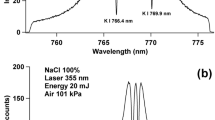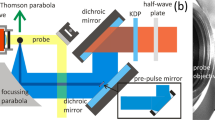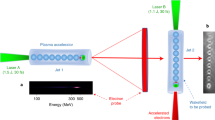Abstract
LASER breakdown, in which a substance is transformed explosively to a plasma by a focused pulsed laser beam, has been much studied1–8. Light emission from the plasma formed by breakdown of liquid media or suspended microparticles is generally observed lateral to the laser beam, and can be used for spectrochemical analysis4,8,9. Here we report the observation of highly anisotropic emission of hydrogen Balmer-α (Hα) radiation from the laser breakdown of polystyrene particles in water. The emission was strong and spectrally narrow in the forward and backward directions (with respect to the beam), and weak and broad in others. The incorporation of a single-mirror cavity in the optical arrangement and the observed nonlinear dependence of intensity on the focal length of the focusing lens suggest that the plasma may induce gain in the emitted radiation. The exact mechanism of the anisotropic emission is not yet known.
This is a preview of subscription content, access via your institution
Access options
Subscribe to this journal
Receive 51 print issues and online access
$199.00 per year
only $3.90 per issue
Buy this article
- Purchase on Springer Link
- Instant access to full article PDF
Prices may be subject to local taxes which are calculated during checkout
Similar content being viewed by others
References
Radziemski, L. J. & Cremers, D. A. (eds) Laser-induced Plasmas and Applications (Marcel Dekker, New York, 1989).
Docchio, F., Regondi, P., Capon, M. R. C. & Mellerio, J. Appl. Opt. 27, 3661–3668 (1988).
Zheng, J., Hsieh, W., Chen, S. & Chang, R. K. J. opt. Soc. Am. B8, 319–327 (1991).
Iida, Y. Appl. Spectrosc. 43, 229–234 (1989).
Latifi, H., Biswas, A., Armstrong R. L. & Pinnick, R. G. Appl. Opt. 29, 5387–5392 (1990).
Kitamori, T., Yokose, K., Suzuki, K., Sawada, T. & Gohshi, Y. Jap. J. appl. Phys. 27, L938–L985 (1988).
Kitamori, T., Yokose, K., Sakagami, M. & Sawada, T. Jap. J. appl. Phys. 28, 1195–1198 (1989).
Kitamori, T., Matsui, T., Sakagami, M. & Sawada, T. Chem. Lett. 2205–2208 (1989).
Cremers, D. A., Radziemski, L. J. & Loree, T. R. Appl. Spectrosc. 38, 721–729 (1984).
Pinnick, R. G. et al. Opt. Lett. 13, 494–496 (1988).
Ali, A. W. & Jones, W. W. Phys. Lett. A55, 462–464 (1976).
Jones, W. W. & Ali, A. W. J. appl. Phys. 48, 3118–3119 (1977).
Elton, R. C. Pumping by Electron Capture into Excited Ionic States: X-Ray Lasers 146–180 (Academic, San Diego, 1990).
Author information
Authors and Affiliations
Rights and permissions
About this article
Cite this article
Nakamura, M., Kitamori, T. & Sawada, T. Highly anisotropic light emission from laser breakdown of microparticles in water. Nature 366, 138–141 (1993). https://doi.org/10.1038/366138a0
Received:
Accepted:
Issue Date:
DOI: https://doi.org/10.1038/366138a0
Comments
By submitting a comment you agree to abide by our Terms and Community Guidelines. If you find something abusive or that does not comply with our terms or guidelines please flag it as inappropriate.



